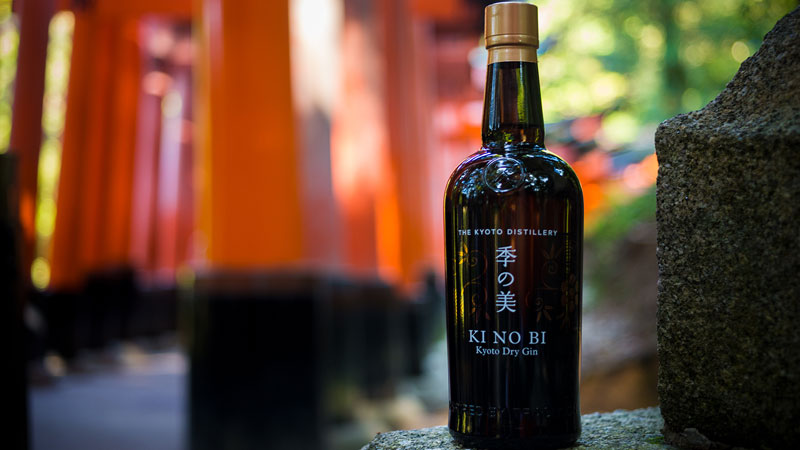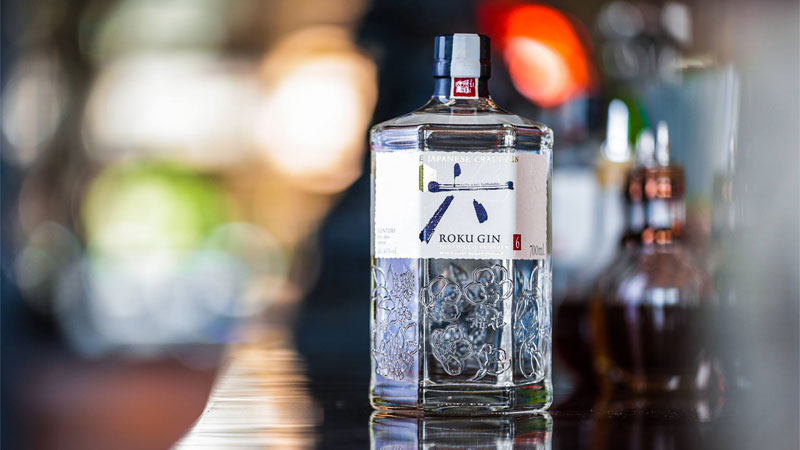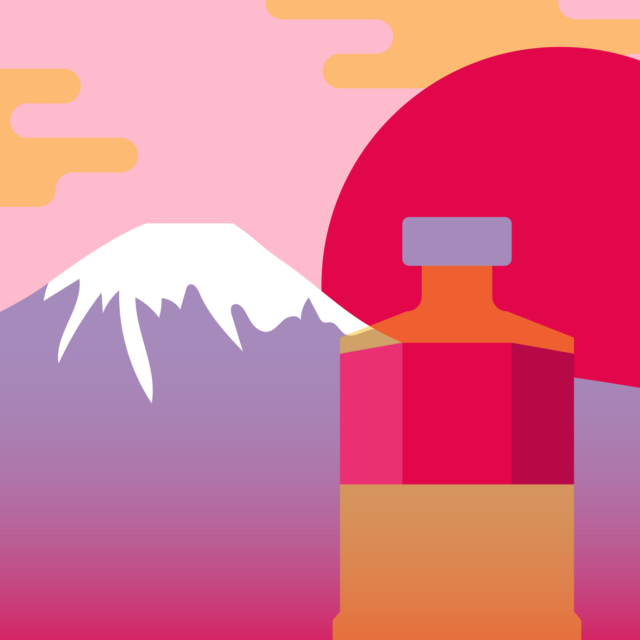In October 2016, Japan’s Kyoto Distillery premiered the country’s first premium domestic gin, KI NO BI. Now, a little more than two years later, 30-plus distilleries are producing gins.
In 2018, exports of Japanese gin grew a staggering 600 percent. The Pacific nation shipped 1.4 million liters over the 12-month period, up from 231,000 liters in 2017.
To put those figures into perspective, exports of Japanese shochu hit 2.2. million liters in 2018. Beefeater alone sells over 25 million liters annually. Clearly, the category is still emerging, but for spirits enthusiasts, Japanese gin offers much to be excited about.
The ascendance of Japanese gin has a lot to do with a powerful predecessor, Japanese whisky.
In 1916, a pioneering Japanese man by the name of Masataka Taketsuru traveled to Scotland to immerse himself in the whisky trade. Following apprenticeships at three distilleries, Taketsuru returned to Japan in 1923 and began working as the master distiller for the Suntory company. In 1936, he started his own brand called Nikka, which would later be incorporated into the Asahi Beverage group.
Seventy years on, both Nikka and Suntory continue to lead the Japanese whisky industry. In 2001, Whisky Magazine crowned Nikka’s 10-Year Yoichi as its “Best of the Best,” while in 2015, Suntory’s Yamazaki Sherry Cask 2013 was named the world’s best whisky by “Jim Murray’s Whisky Bible.” The spirit is so popular, in fact, that there have been well-documented shortages — because whisky requires lengthy aging periods, distillers can’t replenish supplies overnight.
In the meantime, gin, a spirit whose production time can be measured in weeks rather than decades, offers distillers a source of much-needed income. And unlike aging whisky, there’s also a much lower risk of suffering catastrophic damage during natural disasters.
“The success of Japanese whisky over the past 15-20 years has undoubtedly opened overseas consumers’ eyes (and mouths) to the quality and uniqueness of Japanese spirits,” David Croll, founding partner at the Kyoto Distillery, writes VinePair in an email. “When we launched KI NO BI overseas, we were pushing against an open door.”
It was whisky that brought the U.K.-born Croll and his business partner, Marcin Miller, to Japan, and the pair have been exporting the spirit together for more than a decade. When they founded the Kyoto Distillery in 2015, however, they did so with the aim of opening the nation’s first dedicated gin distillery.
“There is no great history of craft gin production in Japan and we like to open new chapters,” Miller said at the time.

When Kyoto released KI NO BI in 2016, it was the country’s first gin to embrace Japanese ingredients, with yellow yuzu, bamboo, gyokuro tea, ginger, and hinoki wood chips included in the gin’s botanical bill. KI NO BI’s distillation method, too, featured innovative techniques. Its botanicals are separated into six different groups, distilled separately, then blended together to create the finished product.
Shortly after KI NO BI’s release, the nation’s heavyweight whisky distilleries got in on the action. In June 2017, Nikka introduced Nikka Coffey Gin in Japan. It began exporting to Western markets later that year.
Nikka’s gin gets its name from the traditional continuous “Coffey” stills used in its production. (The brand imported two Scottish Coffey stills in the 1960s.) The botanical mix includes citrus fruits yuzu, kabosu, amanatsu, and shequasar, plus sansho pepper, juniper, angelica, coriander, and more.
Suntory, which acquired bespoke British gin distillery Sipsmith in 2016, introduced its own Japanese gin in 2017. Named Roku, which means six in Japanese, the name refers to the six different botanicals added during distillation (sakura flower, sakura leaf, yuzu peel, sencha tea, gyokuro tea, and sansho pepper), and is also the inspiration for the gin’s hexagonal bottle.
Roku is currently available in 15 countries, including Japan, China, France, Germany, the U.K., Australia, New Zealand, Taiwan, several South East Asian markets, and, as of October 2018, the U.S. The Japanese version comes in at 47 percent ABV, though the exported version is lowered, slightly, to 43 percent.
Small-scale Kyoto Distillery wants the domestic market to be a major part of its sales — “We’re not simply looking to export something with a ‘Made in Japan’ label,” Croll says — but Nikka focuses on exports. Its “targeted markets were primarily overseas,” Naoki Tomoyoshi, international business development representative for Nikka, tells VinePair. It’s hardly surprising, seeing as how the U.K. — the world’s largest exporter of gin — has seen its gin exports to the U.S. rise by 553 percent over the past decade.

Intriguingly, not all Japanese gins hail from Japan. William Lowe founded Cambridge Distillery in Cambridge, England, as a gin-tailoring business, providing personalized gins for bespoke palates. When high-end Japanese restaurants approached him to produce a “Japanese” gin, Lowe started to investigate Japanese botanicals.
After a year of experimentation, he settled on a combination that, by now, seems very familiar. Yuzu, sesame, shiso leaf, and sansho pepper provided the perfect flavor profiles he was looking for. The gin was so good, he decided to start producing it commercially. In 2015 — over a year before Kyoto introduced its first bottling — Cambridge Distillery’s Japanese gin was awarded Double Gold at the China Wine and Spirits awards.
“I’m absolutely certain it’s no coincidence the botanicals I identified are now the mainstay of all of these emerging Japanese gins,” Lowe says. He likens it to chaos theory and the butterfly effect. “It’s a beautiful thing for me to sit and imagine that the decisions we made here in Cambridge went on to influence an entire category on the other side of the planet,” he says.
Whether or not Lowe’s team singlehandedly created the category is a matter of personal interpretation, but Japanese gins are now thriving in their home market.
In November 2018, Gin-Posium Japan, a seminar and tasting hosted by the Japanese Gin Association, returned to Tokyo for its second appearance. Earlier in the year, more than 3,000 gin lovers turned out for the inaugural edition of GINfest Tokyo, which showcased around 100 different bottlings (both international and domestic).
Tokyo is emerging as an international gin-drinking destination, too. In the Shibuya neighborhood, Good Meals Shop pours more than 350 gins, 20 of which are Japanese. Cocktail Works Jinbocho (located in Jinbocho), is headed by Eiji Miyazawa, a notable figure in the city’s cocktail scene. The bar pours more than 160 craft gins, 25 of which are domestic.
Luckily, you don’t have to travel to Japan to taste many of its best gins. Through specialized online retailers, like dekantã, drinkers around the world can enjoy the delights of the emerging category. Here are a few of our favorites.
Six Japanese Gins to Try
Suntory Roku Gin
Delicate and yuzu-forward, with notes of cherry blossom. Steer clear of overbearing tonic water, and instead mix in a refreshing Martini using five parts gin to every one part of vermouth. Average price: $30.
Nikka Coffey Gin
This gin smells like yuzu peel and fresh lemon and tastes like blistered shishito peppers with a generous seasoning of rock salt. Pours a delicious G&T. Average price: $50.
The Kyoto Distillery KI NO BI
The yuzu in the botanical bill delivers a burst of refreshing citrus, which is perfectly balanced by a crack of prickly sansho pepper. A well-crafted gin with a clean, pure flavor. Average price: $67.
Kozue Japanese Craft Gin
A departure from the citrus-forward style of other Japanese gins, Kozue is driven by green, earthy, pine needle notes. Pairs wonderfully with craft tonic water. Average price: $80.
Masahiro Okinawa Gin
The first gin to be made on the tropical island of Okinawa, Masahiro delivers bursts of tropical fruit and hibiscus flowers, which are kept in check by slightly bitter green notes. Average price: $75.
Cambridge Distillery Japanese Gin
Aromatic and zesty, with a cooling citrus note, this is sipping or Martini gin. Garnish with a fan of green apple à la head distiller William Lowe. Average price: $70.
